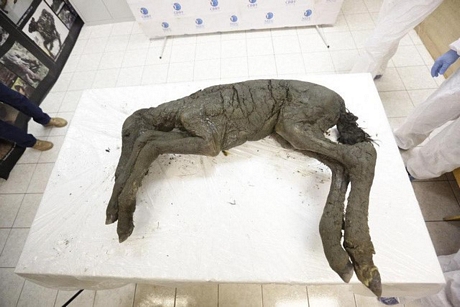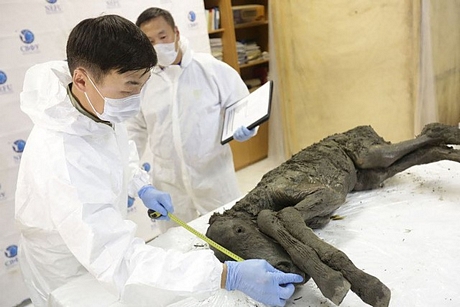The Lena Horse: A 42,000-Year-Old Foal Frozen in Time

Deep within the unforgiving landscape of Siberia’s permafrost, researchers made a discovery so extraordinary it seems almost impossible: the perfectly preserved remains of a 42,000-year-old Ice Age foal, now known as the Lena horse. Unlike typical fossils that offer only bones and fragments, this young creature has been preserved with astonishing detail. Its skin, mane, tail, and even internal organs remain intact, thanks to nature’s most powerful freezer. Most remarkably, scientists found traces of liquid blood and urine still within its body—a phenomenon nearly unheard of for remains dating back tens of thousands of years.

The Lena horse is not just a haunting relic but a time capsule from the Ice Age. Its preservation provides unparalleled insight into prehistoric ecosystems, shedding light on what life was like for the wild horses that once roamed the frozen steppes of Eurasia. Measuring just over three feet in length, the foal appears frozen in eternal sleep, its body a testament to both the harshness and the preserving power of its icy tomb.
For scientists, the Lena horse represents a genetic treasure trove. The discovery of soft tissues and liquid blood opens the door to advanced DNA sequencing. Researchers are hopeful that its genetic code can be mapped in unprecedented detail, potentially unlocking secrets about how Ice Age horses adapted to extreme environments. Beyond that, the idea of cloning—once confined to science fiction—is now a serious consideration. With modern technology, scientists speculate it may one day be possible to bring back an extinct species, reintroducing a lineage lost to time.

But the Lena horse is more than a subject of laboratory curiosity. Its preservation embodies the paradox of life and death, fragility and endurance. The foal likely perished shortly after birth, a tragic fate in an unforgiving climate. Yet that very environment became the guardian of its memory, sealing the young horse in ice for 42 millennia. Today, it allows us to look directly into the face of the past, as if peering across time itself.
This discovery also raises profound ethical and philosophical questions. Should science pursue the path of de-extinction, or should the Lena horse remain a silent reminder of nature’s cycles of survival and loss? Whether or not cloning ever occurs, its preserved form already reshapes our understanding of the Ice Age and the fragile continuity of life.
The Lena horse is not just an ancient foal—it is a story of endurance, a messenger from an age of mammoths and woolly rhinoceroses, when survival meant constant adaptation. It reminds us that even in death, life can speak across the millennia. More than a fossil, it is a frozen testament to the mystery, resilience, and power of nature.
#IceAgeDiscovery #AncientDNA #PrehistoricLife #SiberianPermafrost











